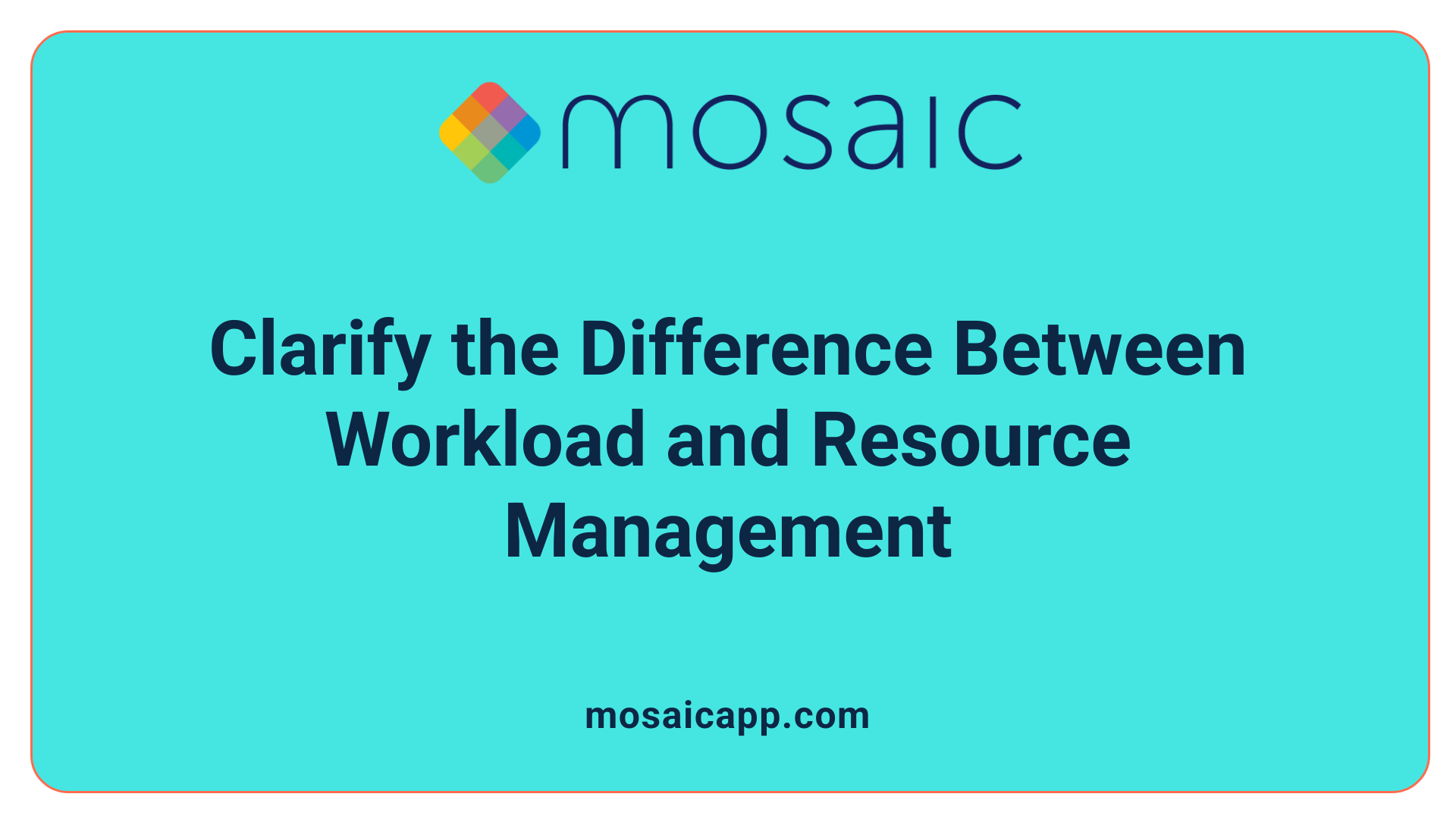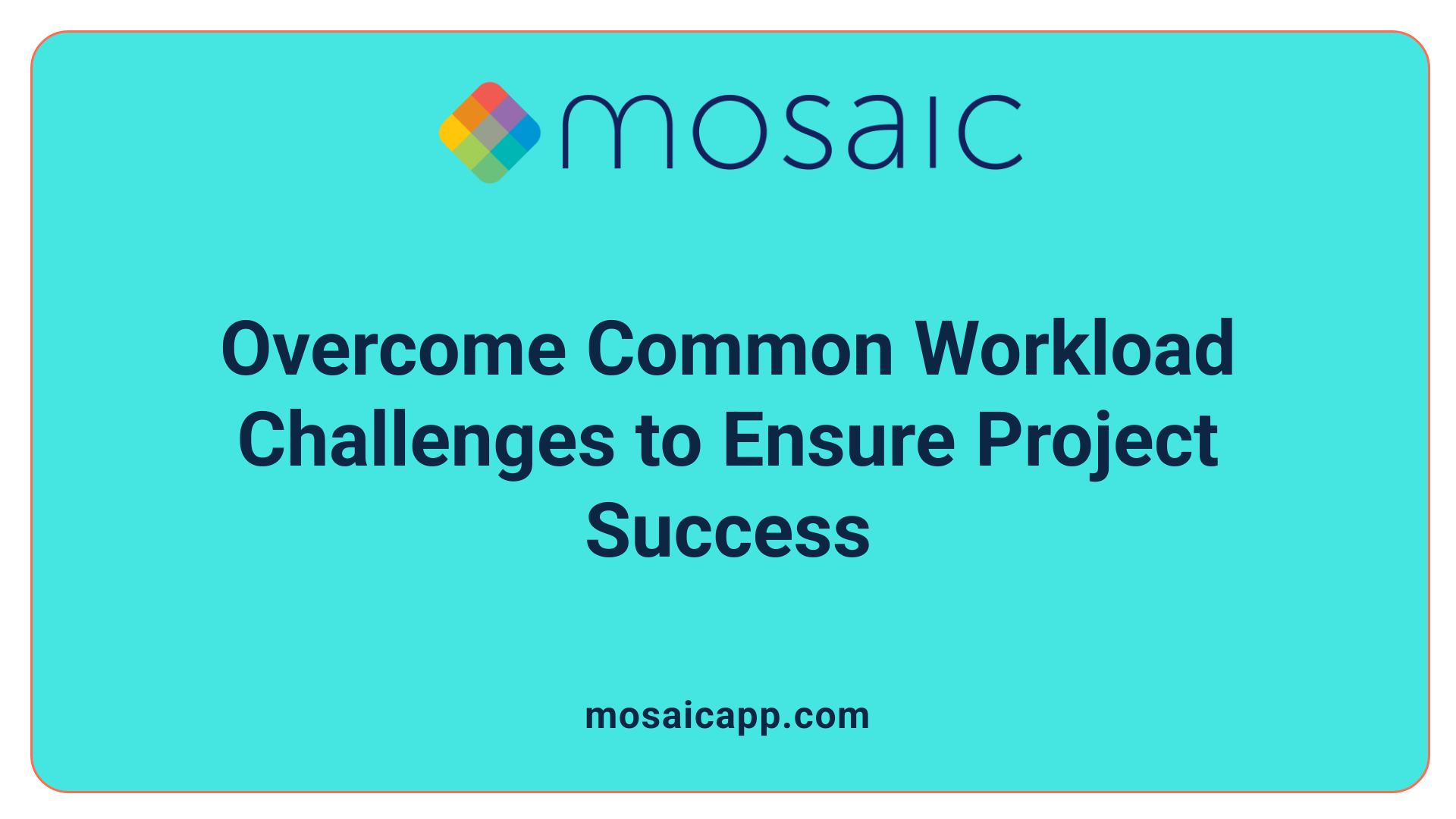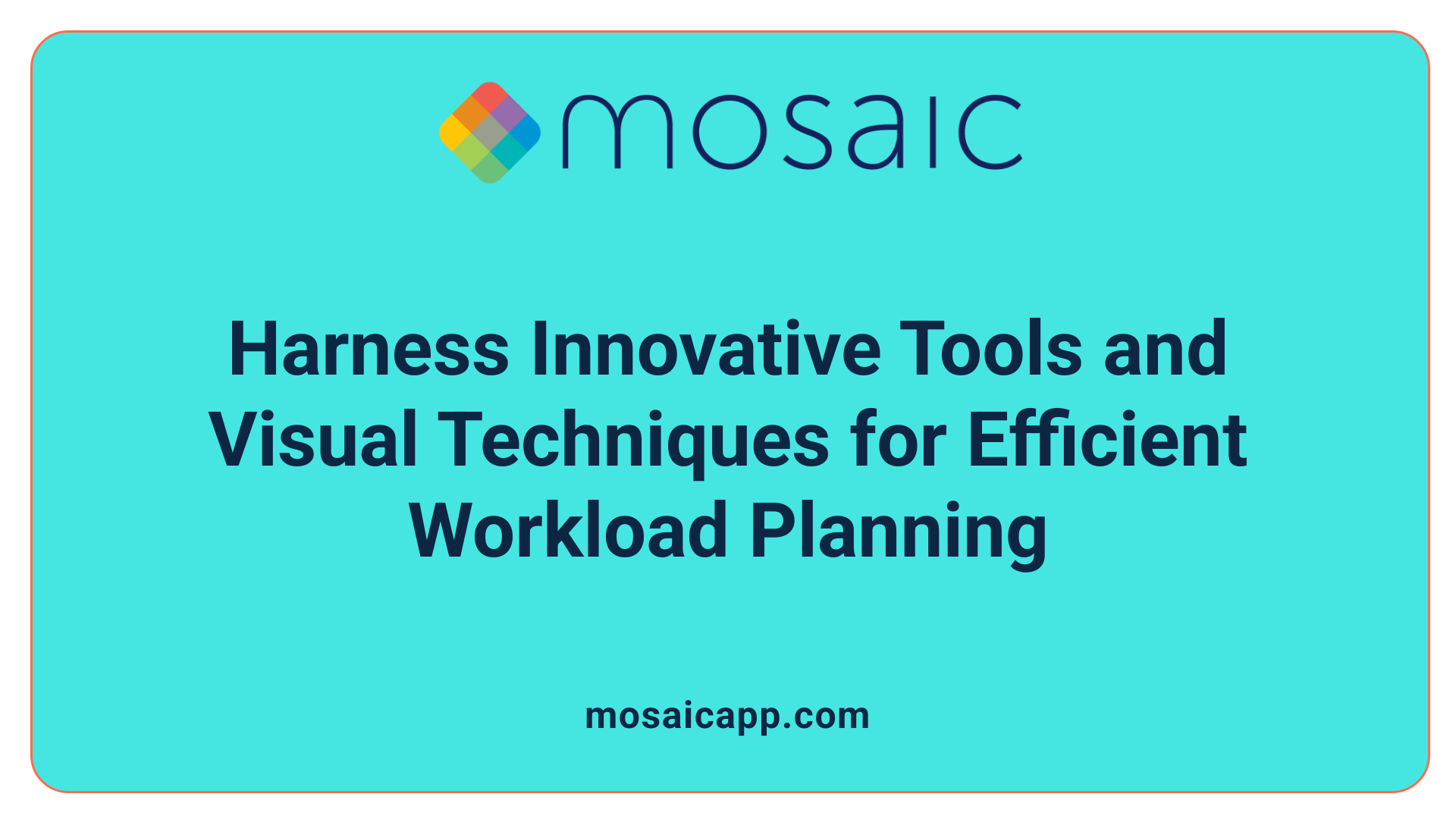Setting the Stage for Smarter Workload Management
In the fast-paced world of professional services, managing workloads efficiently has become a critical determinant of project success. As organizations navigate complexities from remote work to digital transformation, the future of workload management promises more than just task assignment—it heralds a strategic evolution empowered by advanced technologies, adaptive resource planning, and enhanced human skills. This article explores the current landscape and emerging trends that will shape workload management practices, enabling professional services firms to optimize productivity, enhance employee engagement, and drive sustainable project outcomes.
Distinguishing Workload Management from Resource Management

What is Workload Management?
Workload management focuses on the operational aspect of managing tasks and teams on a daily basis. It involves assigning specific tasks, monitoring progress, and ensuring that employees are not overburdened or left underutilized. The goal is to improve project predictability by balancing workloads efficiently, avoiding overwork and idle time.
What is Resource Management?
In contrast, resource management takes a broader strategic perspective. It encompasses overseeing budgets, overall utilization, and aligning resources with organizational goals. Resource management also involves planning how staff, equipment, and other assets are allocated over multiple projects to maximize effectiveness.
How Do Operational and Strategic Roles Differ?
Workload management's role is immediate and tactical — it handles the day-to-day distribution of tasks, adjusting assignments as priorities shift to maintain steady project progress. Resource management, on the other hand, operates at a higher level by analyzing long-term capacity, optimizing workforce skills, and managing financial constraints associated with resource deployment.
What Separates Day-to-Day Task Distribution from Budget and Utilization Oversight?
Day-to-day task distribution ensures tasks match employee skills and availability, often facilitated by tools like Gantt charts and workload management software. Budget and utilization oversight requires a comprehensive view of resource consumption and forecasting, supporting decisions on hiring, training, and investment to meet strategic objectives.
This distinction allows organizations to address immediate operational challenges while aligning resources to future demands and organizational priorities effectively.
Core Principles and Benefits of Effective Workload Management
Avoiding Overload and Underutilization
Effective workload management ensures that team members are neither overburdened nor underutilized. By carefully monitoring task assignments and progress, managers can balance workloads to prevent burnout and idle time, promoting healthier project dynamics.
Proactive Skill Gap Filling
Workload management allows for early identification of skill gaps within teams. This proactive approach enables targeted training or recruitment before these gaps impact project delivery, enhancing overall team capability and performance.
Improved Resource Allocation
By assessing available capacity and employee skills thoroughly, workload management optimizes how resources are assigned. This thoughtful allocation boosts efficiency, ensuring that tasks match team members' strengths and availability.
Preventing Scheduling Conflicts
Rigorous workload planning prevents clashes in scheduling, which can delay projects and strain resources. Visualization tools like Gantt charts and real-time monitoring help maintain clear and conflict-free schedules.
Increased Project Predictability
Managing workloads carefully improves the predictability of project timelines. With accurate capacity calculations and progress tracking, project managers can forecast outcomes more reliably, reducing risks and enhancing stakeholder confidence.
Overall, effective workload management acts as a foundational element for successful project execution by balancing team demands, skills, and timeframes to foster smoother workflows and better results.
Common Challenges in Workload Management and Their Impacts

What Are the Common Challenges in Workload Management?
Workload management is essential for maintaining smooth project execution, yet it faces several obstacles that can undermine project success.
One frequent issue is incorrect task estimates. When estimations do not match the actual effort required, it leads to unrealistic planning and disrupts schedules.
Another challenge is workload overload—assigning too many tasks to team members causes burnout and reduces productivity, while underutilization wastes valuable resources.
Changing project priorities can further complicate workload distribution. Shifting focus mid-project often demands rapid reassignment of tasks, which can create confusion and delays.
How Do Poor Data Visibility and Limited Forecasting Capacity Affect Projects?
Lack of clear, real-time data inhibits effective monitoring, making it difficult to identify bottlenecks or adjust workloads proactively.
Similarly, limited forecasting capacity restricts the ability to predict future resource needs and timelines, increasing the likelihood of unexpected complications.
What Is the Impact of These Challenges on Project Health?
These combined challenges strain team morale and lead to missed deadlines, reduced quality, and increased project risk.
For instance, overload can trigger employee turnover, while unreliable forecasts can cause scheduling conflicts and resource shortages.
Effective workload management requires addressing these pain points through accurate estimates, improved data transparency, and adaptive planning strategies to safeguard project health and success.
Advanced Capacity Planning and Forecasting Techniques
How is capacity calculated after factoring in absences and pre-assigned tasks?
Calculating capacity begins with determining the total available working hours of team members. From this, organizations subtract planned absences such as vacations, sick leave, or training days. Additionally, hours already allocated to pre-assigned tasks must be accounted for to avoid overallocation. This refined calculation ensures a realistic view of the hours available for new assignments, preventing overload and idle time.
How do full-time equivalents (FTEs) aid in forecasting project timelines?
Full-time equivalents (FTEs) represent the workload of an employee relative to a standard 40-hour workweek. Using FTEs to forecast project timelines provides an objective metric to estimate how many staff members are needed and how long tasks might take. By converting employee availability into FTEs, project managers can better align resource capacity with project demands, improving predictability and scheduling accuracy.
What role does resource management software play in capacity assessment?
Resource management software streamlines the capacity assessment process by automatically integrating data on absences, pre-assigned tasks, and employee availability. These tools offer real-time dashboards that visualize capacity, forecast workload distribution, and identify potential bottlenecks in resource allocation. Advanced software may include AI-driven features that adapt capacity plans based on changing priorities, enabling swift adjustments and ensuring balanced workloads.
| Technique | Description | Benefits |
|---|---|---|
| Capacity Calculation | Deducting absences and pre-assignments from total hours | Accurate availability insights prevent overload |
| Full-Time Equivalents (FTEs) | Standardizing workload metrics to forecast staffing needs | Improves project timeline predictions |
| Resource Management Software | Automated tracking and visualization of capacity and workload | Enhances real-time monitoring and dynamic planning |
Modern Tools and Visualization Methods for Workload Planning

Considering Employee Skills and Availability
Effective workload planning begins with a clear understanding of the skills and availability of each team member. This approach ensures tasks are matched with the right expertise, avoiding skill gaps and improving overall project outcomes. Planning must also account for absences and pre-assigned responsibilities, allowing a realistic evaluation of who can take on new tasks.
Gantt Charts and Visualization Tools
Visualization tools like Gantt charts are widely used to translate workload plans into easily understandable timelines. They help allocate resources visually across project phases, illustrating overlaps and dependencies to highlight scheduling conflicts or bottlenecks early. This visual approach supports better decision-making and workload balance.
Role of Workload Management Software in Task Allocation and Monitoring
Workload management software plays a pivotal role in automating task distribution and monitoring progress in real time. Such tools not only allocate tasks based on skills and availability but also enable managers to detect and adjust for overbooked team members or unforeseen changes promptly. Automation reduces manual errors and enhances coordination among team members.
Real-Time Data Usage
Integrating real-time data through management tools gives teams and leaders up-to-the-minute insight into workload status. This visibility is critical for quickly addressing emerging issues such as shifting priorities or unexpected task delays. Real-time monitoring coupled with forecasting capabilities empowers managers to reallocate resources proactively and keep projects on track.
Together, these methods and technologies form the backbone of modern workload planning, combining strategic skill alignment with agile, data-driven adjustments to optimize team performance and project delivery.
Dynamic Workload Adjustments: Handling Overbooking, Vacancies, and Deadlines
How Can Realistic Deadlines Be Set?
Setting realistic deadlines is essential to prevent burnout and ensure project success. This involves assessing current team capacity by calculating available hours after accounting for absences and pre-assigned tasks. Utilizing workload management software allows for visibility into ongoing commitments, enabling better forecasting of timelines using full-time equivalents (FTEs). Incorporating employee skills and availability data also helps adjust timelines to match realistic output expectations.
What Methods Are Effective for Task Redistribution?
Task redistribution is a key response to workload imbalances and unexpected changes. It starts with continuous monitoring of project progress through real-time dashboards provided by workload management tools. Tasks can be dynamically reassigned to suit employees’ expertise or to balance workloads. AI-driven analytics can suggest optimal team compositions and highlight underutilized staff for task reallocation. This flexibility reduces periods of overbooking and idle time, promoting smoother operations.
How Can Vacancies Be Filled Swiftly?
Rapidly filling vacancies is critical to maintain project momentum. Approaches include proactive skills gap analyses to identify potential shortages before they occur. Resource management platforms equipped with AI-driven skills inference engines can match project requirements with available internal or external candidates. Moreover, involving leadership early helps speed up recruitment and onboarding processes. Temporary task redistribution can cover gaps during the transition to minimize disruption.
What Are Best Practices for Managing Unexpected Workload Changes?
Managing sudden workload fluctuations requires agility. This includes regularly updating workload plans, adjusting resource allocations, and setting flexible deadlines. Automated capacity planning tools adapt quickly to shifting priorities, enabling swift task reprioritization. Encouraging open communication and collaboration among remote and hybrid teams ensures issues are identified early. Emotional intelligence, combined with digital tools, helps project managers navigate changes effectively without compromising team wellbeing.
| Adjustment Aspect | Techniques | Tools & Benefits |
|---|---|---|
| Setting Deadlines | Capacity calculation, skill-based timing | Workload management software, FTE forecasting |
| Task Redistribution | Real-time monitoring, AI analytics | Automated task allocation, dynamic resource matching |
| Filling Vacancies | Skills gap analysis, leadership involvement | AI skills inference, accelerated hiring workflows |
| Managing Unexpected Changes | Flexible plans, open communication | Automated capacity planning, collaboration platforms |
Leveraging AI and Automation to Transform Workload Management
How is AI adoption impacting workload management in project settings?
The integration of artificial intelligence (AI) in project management has become widespread, with more than half of organizations using generative AI tools like ChatGPT in significant portions of their projects. This adoption reflects a growing trust in AI to enhance various project phases, from planning and task allocation to progress monitoring.
What role does automation play in managing repetitive project tasks?
AI-powered automation is revolutionizing workload management by taking over routine and administrative tasks that traditionally consumed project managers' time. By automating scheduling, progress tracking, and reporting, organizations can reduce manual errors and free up human resources to focus on more strategic activities.
How does AI improve efficiency and reduce resource wastage?
Through intelligent resource matching and real-time capacity forecasting, AI helps prevent overbooking and underutilization of staff. Automated analytics identify skill gaps and workload imbalances early, enabling timely adjustments that optimize resource allocation and prevent project bottlenecks. This leads to fewer delays, less burnout, and overall enhanced project predictability.
What potentials does generative AI hold for project planning and monitoring?
Generative AI tools offer dynamic scenario modeling to forecast project timelines and staffing needs adaptively. They can analyze historical data to optimize team composition and suggest task redistribution in response to changing priorities. Furthermore, these tools facilitate interactive visualization of workload plans, improving stakeholder communication and decision-making.
AI and automation are not just tools but transformative enablers that make workload management more responsive, precise, and aligned with the fluid demands of modern projects.
Navigating Remote and Hybrid Work Environments
The Rise of Remote Work and Hybrid Models
Remote work is expanding rapidly, with global estimates projecting an increase of about 25% by 2030. Hybrid models, blending in-person and remote work, are becoming the norm for many organizations. This shift is transforming how teams are structured and how workloads are managed.
The Need for Enhanced Communication and Collaboration Skills
Effective communication and collaboration are more critical than ever in remote and hybrid settings. Project managers increasingly rely on digital tools to bridge physical distances, while soft skills like empathy and leadership gain prominence to sustain team cohesion and motivation across locations.
Impact on Workload Distribution and Management Practices
Remote and hybrid arrangements introduce complexities into workload management. Managers must carefully account for employees’ availability, time zones, and capacity when assigning tasks to prevent overload or idle time. Visualization tools such as Gantt charts and real-time monitoring software aid in maintaining transparency and balancing workload effectively.
Furthermore, workload management software supports these environments by facilitating automated task allocation and ongoing progress tracking. It fosters stronger team collaboration, helps forecast capacity with greater accuracy, and allows dynamic adjustments to plans as priorities or workforce conditions change.
Overall, the evolving work landscape demands flexible, technology-enabled workload management strategies that emphasize communication and adapt to varied working patterns for optimal project outcomes.
Essential Digital and Soft Skills for Future Project Managers

Embracing Digital Skills: AI, Cloud Computing, and Cybersecurity
The future project manager must navigate a rapidly evolving digital landscape. Critical digital skills include proficiency in artificial intelligence (AI), cloud computing, and cybersecurity. AI is increasingly embedded in workload management, automating repetitive tasks and supporting capacity forecasting and resource allocation. Cloud computing enables seamless collaboration across remote and hybrid work environments, which are growing substantially — with remote work expected to increase by about 25% globally by 2030. Meanwhile, cybersecurity is paramount given the surge in digitalization and reliance on cloud platforms, requiring project managers to understand protective measures to guard sensitive project data effectively.
Nurturing Soft Skills: Emotional Intelligence, Communication, Empathy, and Leadership
Soft skills are becoming indispensable to manage the complexities of modern teams effectively. Emotional intelligence helps project managers navigate the challenges of remote and hybrid work setups by better understanding team dynamics and individual stressors. Enhanced communication and empathy foster stronger collaboration and trust among diverse and dispersed teams. Leadership skills are especially vital to guide teams through technological and organizational changes, promote engagement, and champion sustainable project goals. Notably, 85% of project managers report increased use of emotional intelligence skills, highlighting their growing importance.
Managing Diverse and Remote Teams with a Blend of Skills
Combining digital proficiency with strong soft skills forms the foundation for successful management of diverse teams. The shift towards fluid, skills-based teams demands managers who can harness data analytics and AI-powered tools for decision-making while maintaining human-centered leadership to motivate and retain talent. As teams become more globally distributed and rely on multiple collaboration platforms, mastering these competencies will be essential to ensure project success and foster a productive workforce in the future.
Sustainability and Social Responsibility in Project and Resource Management

Growing Focus on Environmental and Social Impacts
Sustainability has become a vital consideration in project and resource management. Organizations are increasingly aware that their projects' environmental footprints and social effects play a pivotal role in long-term success and reputation. This growing focus is not just a trend but an essential shift shaping modern project practices.
Consumer and Regulatory Drivers
The push towards sustainability is driven by both consumer preferences and regulatory requirements. Customers today favor companies that demonstrate responsibility towards the environment and ethical social practices. Meanwhile, governments and regulatory bodies are implementing stricter guidelines and standards, urging companies to minimize negative social and environmental impacts.
Integration of Sustainable Practices in Workload Planning
Sustainable project management is extending into workload planning by embedding eco-friendly and socially responsible choices throughout task allocation and resource utilization. This includes prioritizing projects that align with sustainability goals, considering the environmental cost of resources, and ensuring equitable workload distribution to foster social well-being among teams.
Strategic sustainability integration helps ensure projects contribute positively to society and the environment while complying with evolving regulations and meeting customer expectations. By embedding these values into operational workload management, organizations optimize resource use, reinforce their commitment to responsibility, and enhance project outcomes.
Change Management and Leadership in the Digital Transformation Era
What is the role of leadership in digital transformation adoption?
Leadership acts as a critical change agent during digital transformation initiatives. Project leaders and executives guide organizations through transitions by setting clear visions, encouraging adoption of new technologies like AI and automation, and fostering a culture of continuous learning. Early involvement of leadership helps align teams around transformation goals and secures necessary resources, smoothing the path toward modernized workload and resource management.
How can organizations overcome resistance to technology adoption?
Resistance to new technology often arises from uncertainty, lack of skills, and fear of change. Effective change management requires transparency, communication, and upskilling efforts. Leaders play a vital role by addressing concerns, providing training in emerging digital skills such as AI and cloud computing, and demonstrating the benefits of transformation. Engaging employees early and highlighting improved efficiencies and reduced workload pressures helps reduce pushback.
Why is change management important for project success?
Digital transformation impacts workflows, tools, and roles, making structured change management essential to avoid disruptions. It ensures that teams adapt smoothly to new systems, such as AI-powered workload management software, maintaining productivity and preventing burnout or underutilization. Strong change management also helps organizations navigate evolving project environments influenced by hybrid work models and sustainability goals, ultimately supporting successful project delivery and improved resource allocation.
Evolving Resource Management: From Hierarchies to Fluid, Skills-Based Teams
What is driving the shift towards skills-based, agile teams?
The resource management landscape is undergoing a significant transformation, moving away from traditional hierarchical structures to more fluid, skills-based teams. This change is driven by the need for faster project delivery and greater adaptability in dynamic work environments. Instead of fixed roles, teams now form around project outcomes by leveraging specific skills required for each task. This approach supports agility and responsiveness, which are vital in today's fast-evolving project scenarios.
How do resource matching tools enhance employee control and engagement?
Resource matching tools play a crucial role in this new model by allowing employees greater control over their assignments. These tools use sophisticated algorithms to pair individual skills and availability with suitable project tasks, promoting a better fit between team members and work. Empowering employees to contribute where they excel leads to higher engagement levels and boosts job satisfaction. Additionally, giving workers more autonomy in their roles helps improve retention rates and creates a more motivated workforce.
What impact does this shift have on project delivery speed and utilization?
The transition to skills-based, fluid teams positively affects project delivery and resource utilization. By assembling teams according to relevant skill sets, projects benefit from focused expertise, reducing bottlenecks and delays. This tailored allocation enhances efficiency, leading to faster completion times without sacrificing quality. Furthermore, better utilization of human resources is achieved as employees are engaged in tasks that align with their strengths, minimizing both underutilization and overload. Overall, organizations experience improved project outcomes and a more productive workforce through this evolving approach.
Addressing Data Silos and Enhancing Visibility Through Advanced Analytics
The Proliferation of Productivity and Collaboration Apps
Modern workplaces rely heavily on numerous productivity and collaboration applications to support diverse tasks and communication channels. While these tools enhance specific functions, their widespread adoption has led to data being scattered across multiple platforms.
Problems Arising From Data Silos
This fragmentation creates data silos—isolated pockets of information that limit the ability to gain a comprehensive view of project and workload status. Without centralized access, project managers face difficulties in monitoring progress, identifying bottlenecks, and understanding resource allocation accurately. This lack of real-time visibility hampers decision-making and can lead to workload imbalances, scheduling conflicts, and inefficiencies.
Leveraging AI-Powered Reporting and Analytics
To overcome these challenges, organizations are increasingly turning to AI-powered reporting and analytics tools. These technologies integrate data from various sources, providing unified dashboards that offer early detection of potential project issues. By analyzing patterns and forecasting future demands, AI-driven analytics enable proactive workload management decisions. Enhanced visibility supports data-driven choices that optimize resource allocation, improve communication, and boost operational efficiency.
Together, advanced analytics and AI not only help dissolve data silos but also empower project teams with actionable insights, facilitating smoother collaboration and improved project outcomes.
Prioritizing Cybersecurity in an Increasingly Digital Project Landscape
Growing Importance of Cybersecurity
As project management becomes more digital, cybersecurity is critical to protect sensitive data and maintain trust. Increased reliance on cloud-based platforms and collaboration tools introduces vulnerabilities that can be exploited if not properly managed. The rise in remote and hybrid work models further expands potential attack surfaces, necessitating robust security measures.
Proactive Planning and Training
Effective cybersecurity begins with proactive planning. Organizations must embed security protocols into their workload and resource management strategies from the outset. Training employees on cybersecurity awareness, potential threats, and secure practices is essential to minimize risks. Regular updates and simulations can reinforce good habits and prepare teams to respond to incidents.
Security Considerations for Cloud-Based Collaboration and Resource Management Platforms
Cloud-based tools streamline project workflows but require special attention to security. Proper access controls, encryption, and continuous monitoring help prevent unauthorized access and data breaches. As many resource and workload management systems integrate AI and automation, ensuring these technologies adhere to security standards is crucial to safeguard project integrity.
In sum, cybersecurity is no longer optional but a foundational aspect of managing projects in today's digital landscape. Prioritizing it through comprehensive planning, training, and secure technology use protects organizations from emerging digital threats.
Shaping a Resilient and Efficient Future in Professional Services Workload Management
As professional services continue to evolve amidst technological advancements and shifting work paradigms, workload management stands at the forefront of this transformation. The integration of AI-powered tools, emphasis on skill-based resource allocation, and heightened focus on soft skills and sustainability collectively create a blueprint for greater efficiency and resilience. Embracing these innovations while addressing emerging challenges like data silos and cybersecurity will empower organizations to deliver projects more predictably and sustainably. Ultimately, the future of workload management lies in harmonizing technology with human-centric leadership to unlock the full potential of teams in an ever-complex professional landscape.

